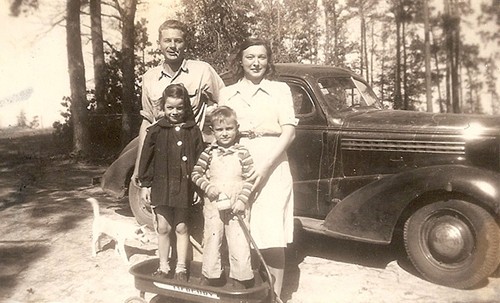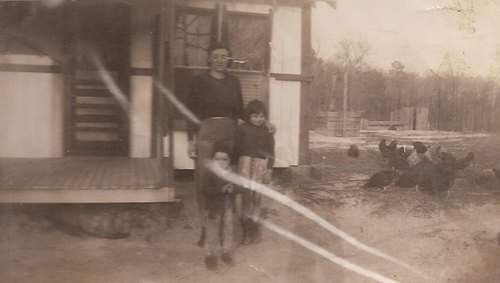|
|
Cheap Gasoline;
Oil and Gas
by N. Ray Maxie
10 Vintage photos courtesy N. Ray Maxie |
 |
Maybe
we all can agree that gasoline is on the front burner
right now; so to speak.
Prices are at historically high levels. Thus it is “up front” on almost
everyone’s mind. My family is thinking about how to use less, economize
and squeeze every bit we can out of every costly gallon. For those
of us in this nation having learned how to be frugal, now is the time
to practice it.
Many larger gas guzzling “high roller” vehicles have
“big” everything, including big gas tanks and low gas mileage.
In recent weeks many folks are very interested in changing their ride.
Down-sizing is becoming so popular the auto dealers can hardly keep
up with the demand for smaller, more economical cars.
I have a friend who sells new, small, economical vehicles and he says,
“As gas prices go higher, my inventory goes lower. Sales are
really good.” Now don’t get me wrong here! He isn’t complaining
one bit; only smiling all the way to the bank.
Larger SUVs and “maxed out” pickups are not selling
well right now. Dealer lots are becoming clogged with those albatrosses.
Their prices have come down drastically, too, as auto dealers try
to move them out. Right now could possibly be a very good time
to buy one. That is, if you can afford the gas for it. I can’t, and
have never been extravagant enough to stretch my budget far enough
for a highly prestigious ride.
My
first car as a teenager was a “country boy” stripped down Austin Healy
station wagon with only two front seats and a windshield. Imagine,
calling that a car! I later traded it for a Cushman motor scooter
and a .22 rifle, to boot.
Along in the summer of 1956, I managed to get a very used 1949 Chevrolet
fleet-line, two door, six cylinder. (Pictured below) That car got
me through highschool in a relatively economical fashion. It burned
casin-head gas real well. We oil field brats, learning
from our elders, burned many gallons of it in our cars. |
 |
| Ray
in wagon with family, in 1942 |
| Ray
with his '49 Chevy, with guitar in back window |
| Ray
and brother-in-law with 1949 Ford, in 1950 |
| Ray
with his father and 1960's Chevy PU, in 1969. |
Some of my other
cars, all economical, in succession were;
1953 Chevrolet Bell Aire, four door, six cylinder. Highly used.
1962 Volks Wagon Beatle, NEW. We drove it 13 years.
1975 AMC Gremlin. NEW.
1982 Toyota Corolla. NEW.
1987 Mazda pickup. NEW.
1995 Nissan pickup. NEW.
1998 Chevrolet Malibu, 4 door, V-6. NEW.
2003 GMC Sierra pickup. Small V-8. NEW.
2008 Toyota Camry, 4 door, 4 cylinder. NEW. Our latest set of wheels.
But,
gasoline is the subject here....... As a young man, I recall gasoline
selling for 19 to 25 cents a gallon at the pump. Now talk about
cheap gasoline, that was during “gas wars” between
oil companies. Long gone are the days when we could pull up to the
pump and tell the attendant, “Give me a dollar’s worth.” Today
that is only about a quart and at 20 MPG, a dollar’s worth would only
take us five miles down the road. |
| Oil
field derrick, Oct. 1937 |
I
grew up in the NE Texas
oil fields and I recall a time when there was a great waste of gasoline
and natural gas. Raw, unrefined gasoline in the oil field is called
“casin-head“ gasoline. It and natural gas were plentiful
during the 1930 and ‘40's. I highly detested the waste that took place
back then.
Living on a rural oil field lease in the Rodessa “field” near McLeod,
we used casin-head gas for about everything imaginable; like starting
a wood fire or burning a pile of brush, rubble or debris. It
was a good grass, weed and bush killer. It was a very good and “unleaded”
solvent for cleaning oily parts, washing greasy hands, etc. Oil field
workers used it for everything except deodorant, which they needed
very badly; or brushing their teeth, which they seldom did anyway.
I recall my mother having to “first wash” dad’s most extremely oily
and greasy over-alls and khaki shirt work clothes in casin-head gas.
They were actually that dirty and grimy.
Casin-head was an excellent insect killer, too. Wasp nest, some pretty
large ones, were very common around a rural place. Tossing about a
quart of the gasoline on a big nest got rid of that wasp problem.
It knocked them dead! Instantly, without any further threat.
About insects.... At least dad didn’t put casin-head
in the little handle pump-up insect sprayer to spray in the house
or over our bed at night for mosquitos, gnats, fleas or bed bugs.
That could have blown the roof off! He only used toxic and dangerous
DDT, instead, which was later outlawed.
You see, being raw and unrefined, casin-head gas is “unleaded” and
very low volatility; meaning it was slow to combust or ignite; thus
much, much safer than the refined, “souped-up”, high-octane gasoline
sold at retail gas pumps. I recall, by way of demonstration, my dad
once threw a “live” Prince Albert roll-your-own cigarette butte into
a puddle of casin-head and it did not ignite. PLEASE DON’T TRY
THIS AT HOME! |
 |
| Oil
field camp house, 1939 |
Dad
had for years, by necessity, always washed his oily, greasy, hard
working hands in casin-head gas. Then, I recall once he had to use
“bought” leaded gas for that purpose and due to cuts or cracks in
his hands and by absorption through the skin, it caused him serious
“blood poisoning.” He vowed never to use leaded gas
for that purpose again.
Gas flow meters throughout the oil patch would accumulate the liquid
condensate called casin-head, and when full the meters needed to be
“blown off” to remove the liquid. Workers would, by necessity, blow
the liquid into a small previously dug pit where it would, over time,
evaporate and/or soak into the ground. Some men would “bail” or dip
the liquid out, placing it into their cans to take home and/or fill
their vehicle gas tanks. |
| Three
Generations: Ray with parents and son, in Nov. '63 |
I
have
written other stories of “real life
experiences” about the rampant theft of casin-head gasoline in
the oil patch where I grew up. Some very interesting experiences indeed,
and sometimes even involved gun shots and auto chases.
Gasoline is lighter than water. Thus it will float on top of water.
One such small “pit” was dug in a cow pasture. I recall a thirsty
cow coming to the casin-head pit and drinking her belly full. She
walked about fifty feet and fell over dead; dead as a hammer! No one
ever thought an animal would drink the stuff. That cow must have been
mighty thirsty.
Now GAS, (IE; natural gas, used in some of our kitchen stoves,
central heaters and water heaters) is the vapor escaping from oil
and gas wells. It is frequently vented into the air and atmosphere
by means of a tall pipe placed well above hazardous ground level.
High enough to dissipate the gas where it causes no problem. Why they
had to vent it and dispose of it that way, is beyond me.
Then, in time, some oil companies and refineries (I know you have
seen this) began to torch the excess gas, disposing of it by flaring
and burning those tall pipes called “flares”. They were
so tall and bright, they would light up an entire refinery complex.
What a waste!... What a waste!.... Today, I don’t see as much
of that needless burning and waste as I once did. Do you?
I most certainly hope, under today’s conditions, it has stopped and
oil companies have become more economially-minded and environmentally
friendly.
I can hear my mother now, saying, “Son, willful waste makes
woeful want.” |
|
|